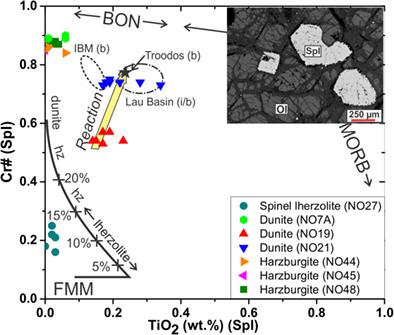当前位置:
X-MOL 学术
›
Geolog. J.
›
论文详情
Our official English website, www.x-mol.net, welcomes your
feedback! (Note: you will need to create a separate account there.)
Petrogenesis of mantle peridotite and cumulate peridotite rocks from the Nagaland Ophiolite Complex, NE India
Geological Journal ( IF 1.4 ) Pub Date : 2021-11-03 , DOI: 10.1002/gj.4314
Aliba Ao 1 , Manavalan Satyanarayanan 2
Geological Journal ( IF 1.4 ) Pub Date : 2021-11-03 , DOI: 10.1002/gj.4314
Aliba Ao 1 , Manavalan Satyanarayanan 2
Affiliation

|
Here, we report new geochemical data from mantle peridotite (spinel lherzolite, dunite, and harzburgite) and cumulate peridotite (websterite) rocks from the northernmost portion of the Nagaland Ophiolite Complex. Based on detailed textural, mineral (major element) chemistry, and whole-rock (major and trace element) chemistry, we reveal the origin of these rocks in different tectonic settings and their modification via the melt–mantle interaction process. The spinel lherzolite rocks with low Cr# (0.16–0.25) chrome spinel are mantle residues formed after low degrees (~10–15%) of partial melting in a mid-oceanic ridge setting, which has been subsequently modified in a subduction zone setting. However, the dunites and harzburgite samples are interpreted to be depleted mantle residue formed in a supra-subduction zone (SSZ) setting. Additionally, the dunites are inferred to be of replacive origin representing former harzburgites. Based on Cr# of chrome spinel, the dunites are classified into low Cr# (0.53–0.57), medium Cr# (0.73–0.79), and high Cr# (0.89–0.90) dunites. High Cr# dunite with low-TiO2 (0.01–0.06 wt%) possibly formed by interaction with a boninitic melt, whereas low-medium Cr# dunite with high TiO2 (0.14–0.34 wt%) formed by interaction with a high-Ti melt in an SSZ setting. Harzburgite samples with their highly resorbed orthopyroxene grain boundaries contain chrome spinels (Cr# = 0.84–0.88; TiO2 = 0.00–0.06 wt%) similar to the high Cr# dunite samples and are also interpreted to be formed by interaction with a boninitic melt. The websterite samples with their low Mg# (0.79) olivine and low Ni (345–413 ppm) content are interpreted to be of cumulate origin formed in an SSZ setting. However, the interstitial chrome spinel blebs with low Mg# (0.18–0.19), high Cr# (0.60–0.61), Fe3+ (0.20–0.21), and very high TiO2 (2.03–2.04 wt%) are interpreted to be a result of post-cumulus interaction of interstitial chrome spinel with high-Ti intercumulus melt. These mantle peridotites and cumulates of different tectonic origins were obducted and juxtaposed during the final stages of the India-Asia collision.
中文翻译:

印度东北那加兰蛇绿岩杂岩地幔橄榄岩和堆积橄榄岩的岩石成因
在这里,我们报告了来自那加兰蛇绿岩复合体最北端的地幔橄榄岩(尖晶石黑闪石、纯纯岩和方镁橄榄岩)和累积橄榄岩(网辉石)岩石的新地球化学数据。基于详细的结构、矿物(主要元素)化学和全岩(主要和微量元素)化学,我们揭示了这些岩石在不同构造环境中的起源以及它们通过熔体-地幔相互作用过程的改变。具有低 Cr# (0.16–0.25) 铬尖晶石的尖晶石岩石是在大洋中脊环境中低度 (~10–15%) 部分熔融后形成的地幔残余物,随后在俯冲带环境中进行了修改. 然而,沙丘岩和方铅矿样品被解释为在超俯冲带(SSZ)环境中形成的贫化地幔残余物。此外,duunites 被推断为代表前 harzburgites 的替代起源。根据铬尖晶石的Cr#,将沙丘分为低Cr#(0.53~0.57)、中Cr#(0.73~0.79)和高Cr#(0.89~0.90)沙丘。高 Cr# 纯晶石,低 TiO22 (0.01–0.06 wt%) 可能由与boninitic 熔体相互作用形成,而具有高TiO 2 (0.14–0.34 wt%) 的低中Cr# 纯长岩是通过在SSZ 设置中与高钛熔体相互作用形成的。具有高度再吸收斜方辉石晶界的方辉石样品含有铬尖晶石 (Cr# = 0.84–0.88; TiO 2 = 0.00–0.06 wt%),类似于高 Cr# 纯岩样品,也被解释为通过与软硬质熔体相互作用形成. Mg# (0.79) 橄榄石和 Ni (345–413 ppm) 含量低的 websterite 样品被解释为在 SSZ 环境中形成的累积成因。然而,间隙铬尖晶石气泡具有低 Mg# (0.18–0.19)、高 Cr# (0.60–0.61)、Fe 3+ (0.20–0.21) 和非常高的 TiO 2(2.03–2.04 wt%) 被解释为间隙铬尖晶石与高钛积云熔体的积云后相互作用的结果。这些地幔橄榄岩和不同构造成因的堆积物在印度-亚洲碰撞的最后阶段被俯冲和并置。
更新日期:2021-11-03
中文翻译:

印度东北那加兰蛇绿岩杂岩地幔橄榄岩和堆积橄榄岩的岩石成因
在这里,我们报告了来自那加兰蛇绿岩复合体最北端的地幔橄榄岩(尖晶石黑闪石、纯纯岩和方镁橄榄岩)和累积橄榄岩(网辉石)岩石的新地球化学数据。基于详细的结构、矿物(主要元素)化学和全岩(主要和微量元素)化学,我们揭示了这些岩石在不同构造环境中的起源以及它们通过熔体-地幔相互作用过程的改变。具有低 Cr# (0.16–0.25) 铬尖晶石的尖晶石岩石是在大洋中脊环境中低度 (~10–15%) 部分熔融后形成的地幔残余物,随后在俯冲带环境中进行了修改. 然而,沙丘岩和方铅矿样品被解释为在超俯冲带(SSZ)环境中形成的贫化地幔残余物。此外,duunites 被推断为代表前 harzburgites 的替代起源。根据铬尖晶石的Cr#,将沙丘分为低Cr#(0.53~0.57)、中Cr#(0.73~0.79)和高Cr#(0.89~0.90)沙丘。高 Cr# 纯晶石,低 TiO22 (0.01–0.06 wt%) 可能由与boninitic 熔体相互作用形成,而具有高TiO 2 (0.14–0.34 wt%) 的低中Cr# 纯长岩是通过在SSZ 设置中与高钛熔体相互作用形成的。具有高度再吸收斜方辉石晶界的方辉石样品含有铬尖晶石 (Cr# = 0.84–0.88; TiO 2 = 0.00–0.06 wt%),类似于高 Cr# 纯岩样品,也被解释为通过与软硬质熔体相互作用形成. Mg# (0.79) 橄榄石和 Ni (345–413 ppm) 含量低的 websterite 样品被解释为在 SSZ 环境中形成的累积成因。然而,间隙铬尖晶石气泡具有低 Mg# (0.18–0.19)、高 Cr# (0.60–0.61)、Fe 3+ (0.20–0.21) 和非常高的 TiO 2(2.03–2.04 wt%) 被解释为间隙铬尖晶石与高钛积云熔体的积云后相互作用的结果。这些地幔橄榄岩和不同构造成因的堆积物在印度-亚洲碰撞的最后阶段被俯冲和并置。

































 京公网安备 11010802027423号
京公网安备 11010802027423号